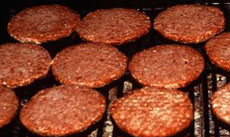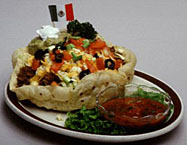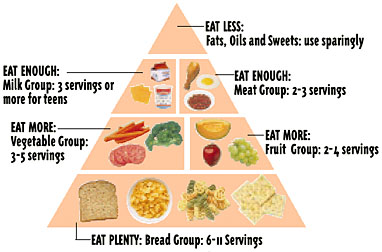|
Click here for the printable (Word) version of the lesson
Group
Four: Meat
 Foods in this group include beef,
pork, fish, shellfish, veal, eggs, poultry, dried beans and nuts.
These foods are valuable sources of protein, B vitamins, iron
and zinc. Although iron and zinc are found in some plant
foods, our bodies use these nutrients better when they come from
animal sources. Foods in this group include beef,
pork, fish, shellfish, veal, eggs, poultry, dried beans and nuts.
These foods are valuable sources of protein, B vitamins, iron
and zinc. Although iron and zinc are found in some plant
foods, our bodies use these nutrients better when they come from
animal sources.
Protein: Helps to build and repair body tissues.
B vitamins: Help keep skin and nerves healthy,
help regulate the digestive system and help use energy from food.
Iron: Helps to build healthy blood. Without
enough iron, you may become anemic. When you are anemic,
you tire faster and more often. You may also feel dizzy and out
of breath. Iron helps you resist infections. Iron
in meats is called heme iron. Foods of plant origin contain
non-heme iron. Egg yolks have mostly non-heme iron. Heme
iron in meats is better absorbed by the body. To make non-heme
iron more absorbable, add a vitamin C rich food or a small amount
of meat to your meal.
Zinc: This mineral is important for the brain
to develop and function as it should. Zinc also plays an
important role in pregnancy. Women who have low levels
of zinc early in pregnancy are more at risk of having a low-birth-weight
infant. Low-birth-weight infants have more severe complications
and are less likely to live beyond infancy than infants who have
normal birth weights. Zinc is necessary to have a healthy
immune system to fight infections and illness.
When you don't get enough zinc, any health problems you have,
such as an infection, burn or diabetes could get worse.
How Much Meat to Eat?
Foods from this group should be eaten in moderation.
Every day, adults, teens, and children need to eat two to three
servings from the meat, poultry, fish and bean group of the Food
Guide Pyramid.
How Much is a Serving?
 A serving is two or three ounces
of cooked LEAN meat, poultry, or fish without bones. Three
ounces of meat is about the size of a deck of cards. One
egg counts as one ounce of meat (about one-half of a serving).
Try to have no more than three to four eggs a week because eggs
are high in cholesterol. Count one-half cup of cooked dried
beans or peas as one ounce. Count two tablespoons of peanut
butter as one ounce of meat. A serving is two or three ounces
of cooked LEAN meat, poultry, or fish without bones. Three
ounces of meat is about the size of a deck of cards. One
egg counts as one ounce of meat (about one-half of a serving).
Try to have no more than three to four eggs a week because eggs
are high in cholesterol. Count one-half cup of cooked dried
beans or peas as one ounce. Count two tablespoons of peanut
butter as one ounce of meat.
We need a total of five to seven ounces of cooked lean meat
each day. Let's see how we can get this amount from the
different foods in the meat group. For example, six ounces
might come from:
One egg for breakfast = one ounce of lean meat +
Two ounces sliced turkey in a sandwich at lunch +
Three ounces cooked lean hamburger for dinner =
Lowering the Fat in Your Diet
Most of the fat we consume comes from the meat group.
Some ways to cut down on the fat intake from foods in this group
include:
1. Select lower-fat choices of beef and pork from
the meat group. Generally, beef cuts with loin
or round in the name and pork cuts with loin in
the name are the leanest choices. In addition, select USDA
Select grade for beef. Select grade is generally leaner
than Choice because it has less marbling (fat) and less fat on
the edges. The fewer white specks you see in beef, the
leaner the meat.
2. Select fish and poultry more often than beef.
Fish and poultry are lower in fat content than beef. The
greatest concentration of fat in poultry is in the skin.
The Louisiana State University Department of Poultry Science
recommends to cook poultry with the skin on, then remove the
skin before eating. The poultry will be moister and more
flavorful by following that procedure.
3. Cook in ways to reduce rather than add fat.
Broil or roast on a rack. These cooking methods require
no added fat. Tenderize lean cuts by cooking slowly with
moist heat, cooking in liquid or marinating. Pounding and
slicing across the grain also help. Remove fat from soups,
stews and casseroles by chilling them and skimming the hardened
fat from the top. Cut off all visible fat from the meat
before cooking and eating.
4. Eat less meat. When we enjoy smaller
portions of meat, we fill the rest of our plates with fruit,
vegetables, beans and rice, noodles or bread. Stretch
smaller portions of meat and make them more interesting by cooking
them with vegetables in soups, stews, casseroles and stir-fried
dishes.
Choose More
- Baked or stewed chicken with the skin removed. Remove the
skin after the chicken is cooked.
- Roast turkey.
- Lean ground beef or ground turkey.
- Fish canned in water.
- Leaner cuts of beef (Beef cuts with loin or round in the
name are generally leaner choices.)
- Lower-fat packaged lunch meats, like turkey ham, smoked or
baked chicken breast, very thinly sliced chicken, turkey, ham,
roast beef, boiled ham, honey loaf, turkey pastrami and lower-fat
hot dogs.
- Poached or hard-cooked eggs.
- Dry beans and peas cooked without added fat such as bacon
grease or ham hocks.
- Peanut butter limited to two tablespoons.
- Nuts once in a while.
Choose Less
- Fried chicken or turkey.
- Regular ground beef or pork.
- Fish canned in oil.
- Beef cuts higher in fat, such as brisket, chuck blade roast
steak or ribs.
- Regular sandwich meats like salami and bologna, hot dogs
and sausage.
- Fried or scrambled eggs.
- Dry beans and peas cooked with added fat such as bacon grease,
lard or ham hocks.
- Peanut butter
- Nuts
Food Safety
Many cases of foodborne illness result from the mishandling
of food in the home. Prevent foodborne illness by handling,
cooking and storing food properly.
1. Cook meats to proper degree of doneness.
A good one-time purchase for your money is a meat thermometer.
A meat thermometer tells you the degree of doneness of the meat
or poultry. Beef, except for ground beef, can be cooked
to rare (145 degrees F); pork should reach at least 160 degrees
F and poultry should reach at least 180 degrees. The exception
is turkey breast, which is safe at 170 degrees F. The USDA
recommends thorough cooking of raw meat products. Disease-producing
bacteria are destroyed when the meat is fully cooked.
Ground beef should be cooked until it's well-done or cooked
to at least 160 degrees F. An instant read thermometer
is the best way to check temperature and the safest practice.
If you don't have a thermometer, ground beef should be gray in
color. Cook ground beef until you do not see any pink and
juices run clear. Never eat ground beef rare or raw!
Ground meat is especially susceptible to bacteria because the
surface can be contaminated and the grinding spreads the bacteria
throughout the meat. Disease-producing bacteria are destroyed
when meat is fully cooked.
2. Do not allow cooked meat to stand at room temperature.
It is a good candidate for bacterial growth at temperatures between
40 degrees and 140 degrees F. Refrigerate leftovers immediately.
3. Marinate meats properly. While marinating,
meats should be covered and refrigerated. Do not use marinade
for basting.
4. Keep hot foods hot (140 degrees to 165 degrees
F). Bacteria can multiply rapidly at lower temperatures.
5. Watch out for cross contamination. Do
not expose food to the drippings from raw meat; for example,
don't put cooked meat back on the same unwashed cutting board
that held raw meat and don't cut vegetables on the same board.
Wash hands, work surfaces and utensils with hot, soapy water
after they've come in contact with raw meat. Non-wooden
cutting boards which can be thoroughly scrubbed in hot water
are preferred.
6. Do not partially cook food, then finish cooking
it the next day. Partial cooking encourages bacterial
growth, which may not be destroyed in further cooking.
7. Keep refrigerator and freezer at proper temperatures.
Refrigerators should be 40 degrees F or slightly below;
freezers at 0 degrees F.
Web
Sites to Visit:
www.hot-dog.org - Click
on Concerned About Calories.
www.eatchicken.com
- Click on Safe Handling to learn more about food safety.
Click on Short Cuts to learn how to cut a whole chicken.
Click on Chicken Parts to learn about the different parts
of the chicken. Click on Talking Chicken too.
www.beeftips.com -
Visit this site for low-fat cooking methods and cuts of beef,
beef safety and healthy beef recipes.
www.beefnutrition.org
- Click on Beef Facts.
www.nppc.org - Click
on Food & Nutrition Info for nutrition facts, recipes,
and cooking tips.
www.aeb.org - Click on Basic
Egg Facts, Food/Nutrition, Egg Recipes, and
Egg Safety.
Group Five: Milk, Yogurt and Cheese
 Calcium is another important part
of the diet. It's the mineral your body uses to build bones
and teeth. When you don't get enough calcium when you're
young, you could suffer from osteoporosis when you get older.
This is a painful disease where the bones become brittle and
break very easily. Calcium is another important part
of the diet. It's the mineral your body uses to build bones
and teeth. When you don't get enough calcium when you're
young, you could suffer from osteoporosis when you get older.
This is a painful disease where the bones become brittle and
break very easily.
Getting enough calcium is especially important during pregnancy.
Your baby needs calcium to build its bones and teeth.
Since your baby gets its nourishment from you, it is important
that you eat a diet high in calcium. Breast-feeding women also
need extra calcium for themselves and their babies.
Babies, young children and teenagers need calcium because
their bones and teeth are growing very fast.
Milk and milk products are our best source of calcium.
Good non-dairy sources include sardines and other fish canned
with the bones, dark green leafy vegetables and shellfish.
Foods made with milk and milk products like macaroni and cheese,
cream soups, puddings, custards and tacos also provide calcium.
It's important that you eat a variety of calcium-rich foods every
day.
It's easy to get calcium without extra fat. Learn to
read the labels and select low-fat or non-fat products.
In fact, skim and low-fat milks have more calcium than regular
milk.
If you have trouble drinking milk because of bloating and
gas, you probably have lactose intolerance. That means
you don't have the lactase enzyme needed to digest the lactose
(sugar) in milk. Choose lactose- reduced milk, acidophilus
milk, lact-aid tablets or drops or fermented dairy products such
as buttermilk and yogurt or simply try drinking smaller amounts
of milk at a time.
You
Can Stretch Your Food Dollars By:
- Choosing large containers - they generally cost less per
serving.
- Buying store brands - these are usually less expensive.
- Using non-fat dry milk - it can be reconstituted or reconstituted
and mixed half and half with fluid milk.
- Using evaporated milk - it can be reconstituted by adding
an equal amount of water and used in place of fluid milk in recipes.
Tips That Will Help:
Canned evaporated milk and non-fat dry milk can be used in
most recipes calling for fresh fluid milk. Here's how to
mix...
- 1/2 cup evaporated milk and 1/2 cup water = 1 cup regular
milk
- 1/2 cup skimmed evaporated milk and 1/2 cup water = 1 cup
skimmed milk
- 1/2 cup nonfat dry milk and 2/3 cup water = 1 cup skimmed
milk
Evaporated Milk
- Use evaporated milk straight from the can in making mashed
potatoes, macaroni and cheese, puddings and many other dishes.
- Chill evaporated milk and you can whip it just like cream.
- Evaporated skimmed milk has all the calcium and protein of
milk without the fat.
- Evaporated milk must be stored in the refrigerator after
opening.
Fresh fluid milk, milk products, opened canned milk and reconstituted
dry milk should be kept refrigerated and covered. This
will help it to stay fresh a long time. Store nonfat dry
milk powder in a tightly covered container in a cool dry place.
How Much Calcium Do You Need?
|
If your
age is: |
You need this
much calcium: |
|
1-3 |
500 mg |
|
4-8 |
800 mg |
|
9-18 |
1300 mg |
|
19-50 |
1000 mg |
|
51+ |
1200 mg |
|
Pregnant and nursing teens up to age 18 |
1300 mg |
|
Pregnant and Nursing women 19 and older |
1000 mg |
* Professionals in the area of nutrition believe we need
more calcium. The National Institutes of Health recommends 1,000
mg for premenopausal and estrogen-treated women. They also recommend
1,500 mg for postmenopausal women not treated with estrogen.
Putting the Pyramid Pieces Together to Build a Nutritious
Diet
Our bodies are like cars. Cars need gas to go.
We need food to go, grow and be healthy. Food we eat breaks
down inside our bodies into nutrients. Nutrients are the
very small, individual parts of foods that our bodies need to
live. Nutrients include: protein - for building and repair;
carbohydrate - for energy; fat - for energy; vitamins - help
protein, fat and carbohydrate do their jobs; minerals - body
structure and help other nutrients do their jobs.

Eating the right types and amounts of foods is very important
for us to get all the nutrients we need to be healthy.
Variety and balance are the important ideas for a good food
plan. No one food contains all the nutrients we need.
Following the Food Guide Pyramid helps us to eat a variety of
foods. Eating a variety of foods helps us get all of the
needed nutrients.
Several nutrients are lacking in many of our diets.
They are listed below in the order of being the most deficient
in our diets:
1. Folacin - important for normal growth and
reproduction, for the prevention of blood disorders and for mechanisms
within the cells.
2. Vitamin B-6 - helps in amino acid metabolism
and in having a healthy nervous system. Vitamin B-6 deficiency
in adults may cause depression, confusion and convulsions.
3. Zinc - helps make enzymes, helps wounds heal,
builds blood and helps growth to occur as it should.
4. Iron - builds red blood cells for healthy
blood supply and helps carry oxygen to all parts of the body.
Foods rich in these nutrients include:
- Folacin - liver, dry beans and dark green, leafy vegetables.
- Vitamin B6 - fish, poultry and meats (especially liver),
some vegetables (including potatoes), whole-grain cereals and
bananas.
- Zinc - animal meats such as red meat, liver, poultry and
also seafood such as oysters and other shellfish are the best
sources of zinc. Plant sources include dry beans and whole-
grain cereals. Your body can use zinc from animal sources
better than zinc from plant sources.
- Iron - beef, liver, oysters, enriched breads and cereals,
green, leafy vegetables - kale and collard greens, dried beans
and peas, dried fruits and broccoli.
Calcium, vitamins A and C and iron are included on the
Nutrition Facts label because they are problem nutrients.
Web Sites
To Visit
www.whymilk.com
www.dairycouncil.org
Click on General Information.
www.ilovecheese.com
   [ LESSONS || SITE
MAP || LOCAL AGENTS || RESOURCES || PEOPLE ]
[ LESSONS || SITE
MAP || LOCAL AGENTS || RESOURCES || PEOPLE ]
Issued in furtherance of Cooperative Extension
work, Acts of Congress of May 8 and June 30, 1914, in cooperation
with the United States Department of Agriculture. The Louisiana
Cooperative Extension Service provides equal opportunities in
programs and employment. Information and Graphics on this site
are copyright protected by LSU Agricultural Center's Louisiana Cooperative Extension Services.
For more information
on the EFNEP program, contact EFNEPMail@agcenter.lsu.edu.
|